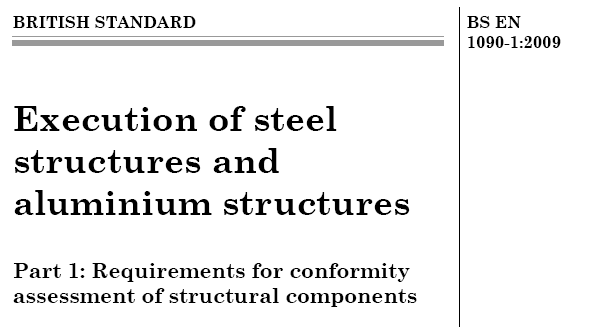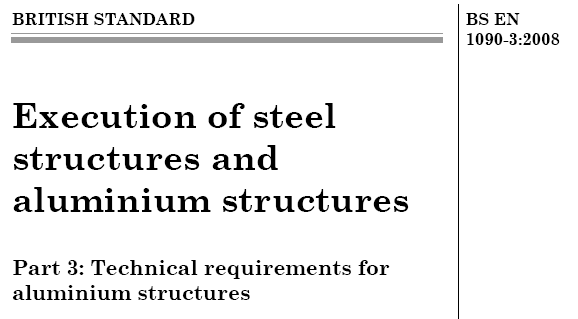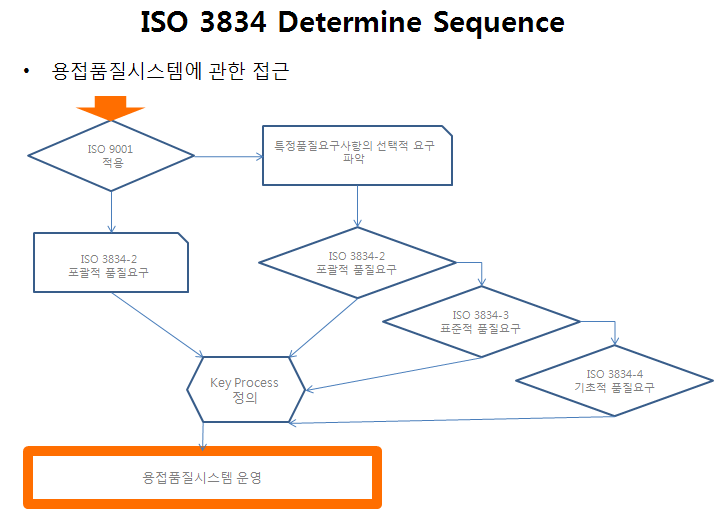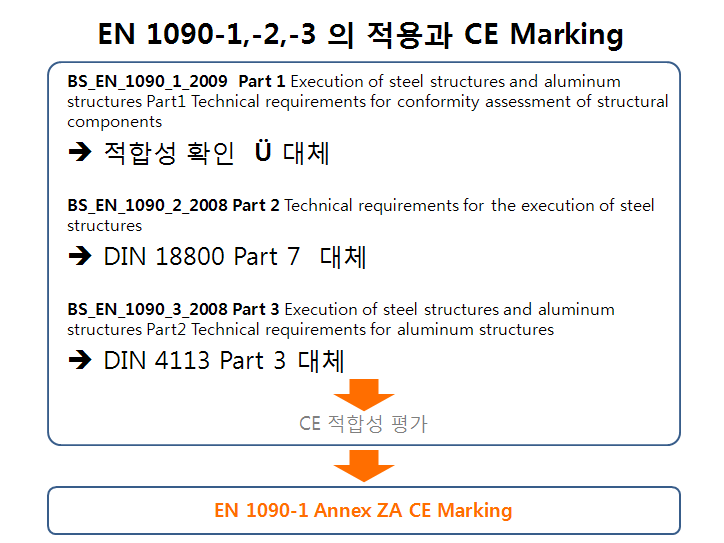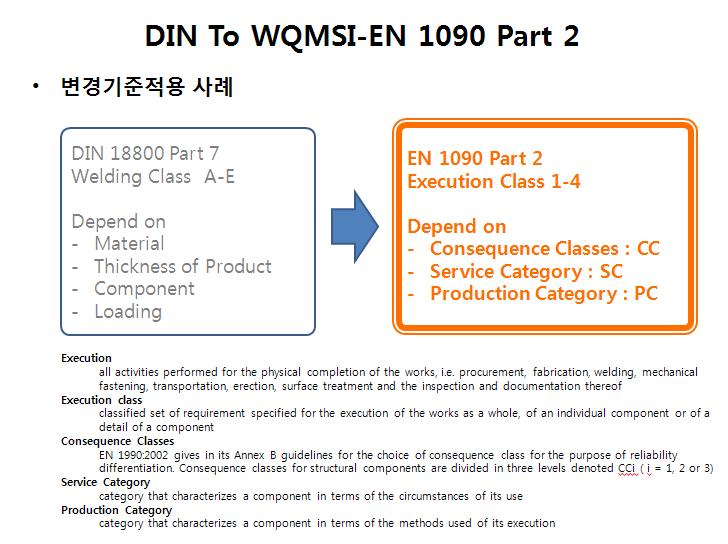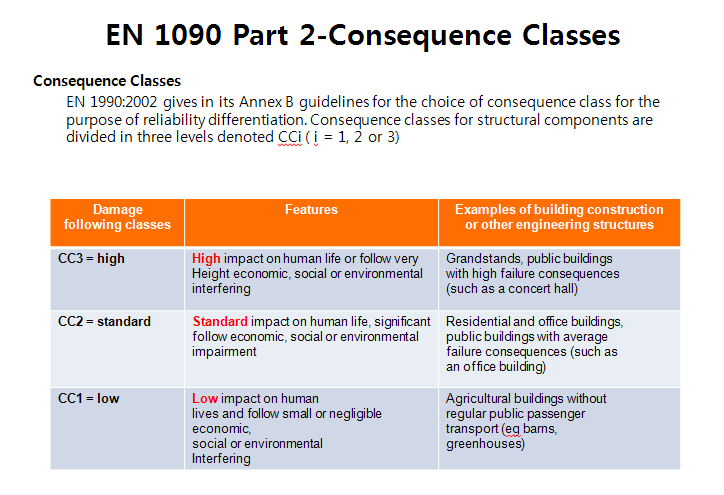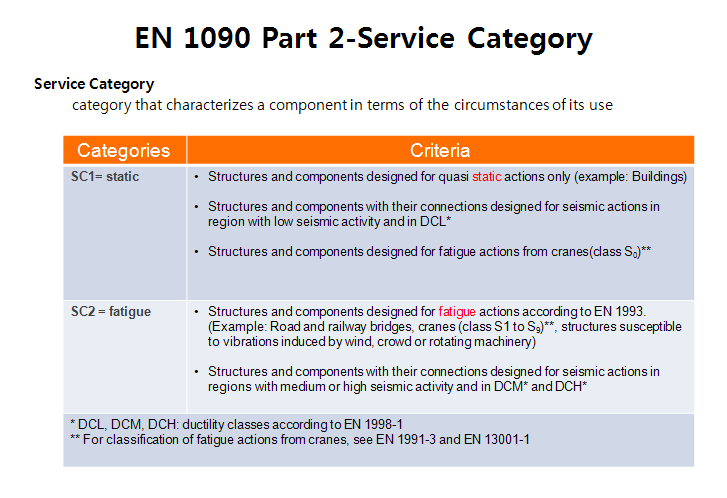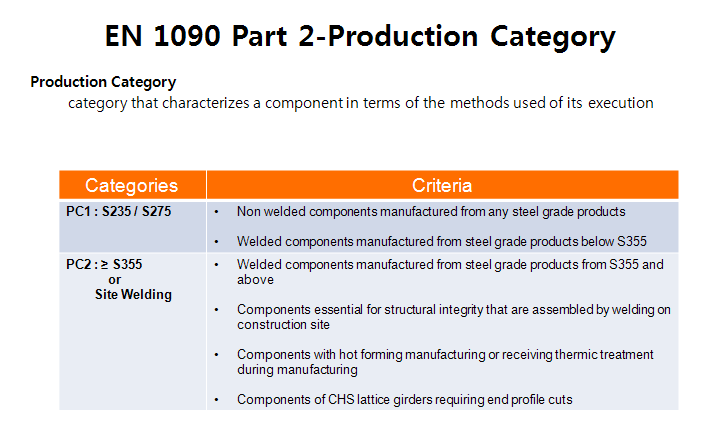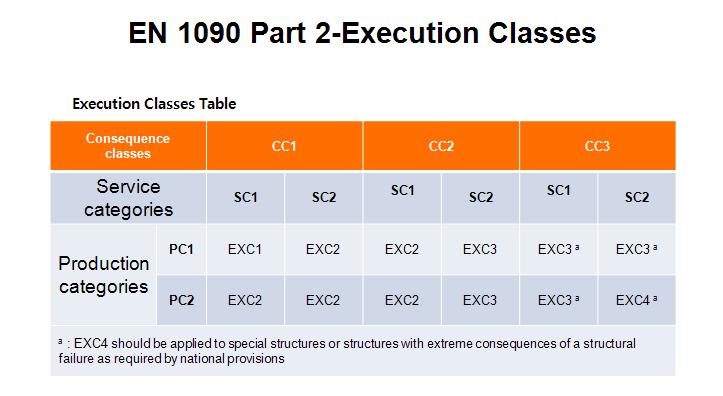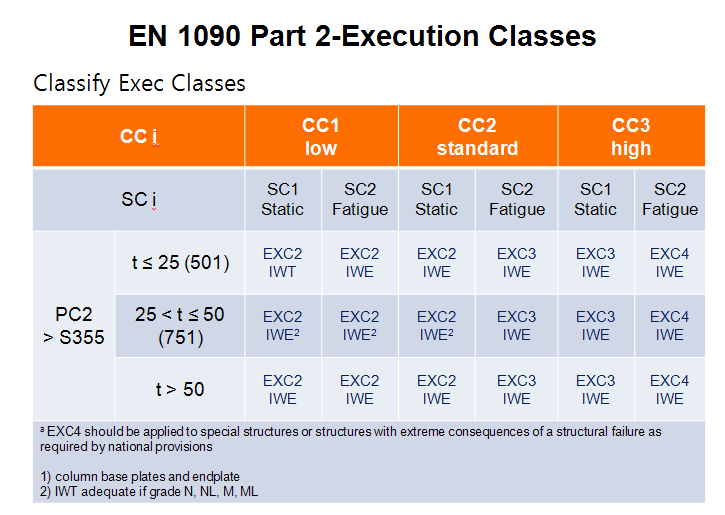EN 1090-1 Execution of steel structures and aluminium structures Part1 Requirements for conformity assessment of structural components
EN 1090-1 Execution of steel structures and aluminium structures Part1 Requirements for conformity assessment of structural components
유럽지역으로 수출하는 철강 및 알루미늄 구조물은 European Commission Communication 2010/C 344/01이 2013년 7월 1일 이후 발효됨으로써 필수적으로 EN 1090 에 따라 인증을 취득하여야 합니다.
이 규격의 많은 부분이 용접과 기계조립 등에 관련된 사항으로써 그 내용은 다음과 같습니다.
- EN 1090-1 :2009 Execution of steel structures and aluminium structures Part 1: Requirements for conformity assessment of structural components [적합성 평가]
- EN 1090-2 Execution of steel structures and aluminium structures — Part 2: Technical requirements for steel structures[철구조물에 대한 기술적요건]
- EN 1090-3 Execution of steel structures and aluminium structures — Part 3: Technical requirements for aluminium structures[알루미늄구조물에 대한 기술적 요건)
- 기타 관련 규격
- EN 1990:2002 Eurocode: Basis of structural design
- EN 1991 (all parts) Eurocode 1: Actions on structures
- EN 1993 (all parts) Eurocode 3: Design of steel structures
- EN 1994 (all parts) Eurocode 4: Design of composite steel and concrete structures
- EN 1998 (all parts) Eurocode 8: Design of structures for earthquake resistance
- EN 1999 (all parts) Eurocode 9: Design of aluminium structures
- EN 10045-1 Metallic materials — Charpy impact test — Part 1: Test method
- EN 10164 Steel products with improved deformation properties perpendicular to the surface of the product — Technical delivery conditions
- EN 13501-1 Fire classification of construction products and building elements — Part 1: Classification using data from reaction to fire tests
- EN 13501-2 Fire classification of construction products and building elements — Part 2: Classification using data from fire resistance tests, excluding ventilation services
- EN ISO 9001 Quality management systems — Requirements (ISO 9001:2000)
- EN ISO 14731 Welding coordination — Tasks and responsibilities (ISO 14731:2006)
- ISO 7976-1 Tolerances for building — Methods of measurement of buildings and building products — Part 1: Methods and instruments
- ISO 7976-2 Tolerances for building — Methods of measurement of buildings and building products — Part 2: Position of measuring points
- ISO 17123-1 Optics and optical instruments — Field procedures for testing geodetic and surveying instruments — Part 1: Theory
EN 1090-1 의 목차 내용
A. Requirements
1. Constituent products
1.1 General
1.2 Constituent products for steel components
1.3 Constituent products for aluminium components
2 Tolerances on dimensions and shape
3 Weldability
4 Fracture toughness
5 Structural characteristics
5.1 General
5.2 Load bearing capacity
5.3 Fatigue strength
5.4 Resistance to fire
6 Reaction to fire
7 Dangerous substances
8 Impact resistance
9 Durability
B. Evaluation methods
1 General
2 Constituent products
3 Tolerances on dimensions and shape
4 Weldability
5 Fracture toughness
6 Structural characteristics
6.1 General
6.2 Structural design
6.3 Manufacturing characteristics
7 Resistance to fire
8 Reaction to fire
9 Dangerous substances
10 Impact resistance
11 Durability
C. Evaluation of conformity
1. General
2 Initial type testing
2.1 General
2.2 Characteristics
2.3 Use of historical data
2.4 Use of structural calculations for conformity assessment
2.5 Initial type calculation
2.6 Sampling, evaluation and conformity criteria
2.7 Declaration of performance characteristics
2.8 Recording of results from evaluations
2.9 Corrective actions
3. Factory production control
3.1 General
3.2 Personnel
3.3 Equipment
3.4 Structural design process
3.5 Constituent products used in manufacture
3.6 Component specification
3.7 Product evaluation
3.8 Non-conforming products
적용제외 품목
다만, 아래의 경우 EN 1090을 적용하지 않습니다.
CASES WHERE THE CE MARKING IS NOT POSSIBLE ON THE BASIS OF EN 1090-1
A) Steel and aluminium products which are not covered by the scope of EN 1090-1 therefore CE marking on the basis of EN 1090-1 is not possible:
Steel and aluminium products which are not produced in the “factory” of the manufacturer (products made on the worksite are not covered by EN 1090-1)
Components of cast iron, of cast steel and steel forgings
Rails and sleepers for railway systems
Blind rivets
Cabinets for cables and power supply installations
Cables, ropes and wires
Castings
Components for suspended ceilings
Doors
Fences and railings
Flagpoles
Forgings
Foundation bolts
Gates
Ladders
Ornamentations
Piles (non-fabricated)
Pipelines and pipes
Pressure vessels
Rails or sleepers for railway systems
Reinforcing steel for concrete or masonry
Roof safety products incl. roof ladders and walkways
Self-drilling and self-tapping screws
Site based activities
Structural components for cranes
Structural components for offshore structures
Structural components for wind turbine towers
Traditional craft type and non-structural components (e. g. weather cocks, letter boxes, bicycle racks, fences).
B) Other products which, even if they are covered by EN 1090-1 they cannot be CE marked under that standard.
Products covered by EN 1090-1 have to CE marked after the coexistence period on the basis of EN 1090-1 only if they satisfy all the following conditions:
they are intended to be used in works which are buildings or civil engineering works, and
they are incorporated in a permanent manner in the construction works
they have a structural function in relation to the construction work
they are not covered by another specific harmonised EN, or by an ETAG or by an ETA
they are construction products within the meaning of Article 2(1) of Regulation 305/2011
After applying the above criteria one arrives to the conclusion that the following steel and aluminium products can NOT be CE marked on the basis of EN 1090-1 for the following reasons:
B.1 Steel and aluminium products intended to be used use in works which are not buildings or civil engineering works e.g.:
for the construction of off-shore oil platforms,
for wind turbines and their supporting columns
for the construction of oil refineries
B.2 Steel and aluminium products which are not incorporated in a permanent manner in construction works (e.g.):
scaffoldings
B.3 Steel and aluminium products which do not contribute to the satisfaction by the building (or by the civil engineering work) of Basic Work Requirement Nr. 1 Mechanical resistance and stability, e.g.:
supports for machines, or for other industrial equipment (because they support the machine not the building)
for cables and power supply installations systems (e.g. storage selves)
fences without structural role
handrails / balustrades
ladders
ornamentations
pressure vessels
windows/doors and facade systems without structural role
B.4 Steel and aluminium products covered by other European technical specifications:
B.4.1 Steel and aluminium products specifically covered by harmonised standards.
In these cases, there is a specific standard other than EN 1090-1 which is (or will be) the basis for the DoP and for affixing the CE marking on the product.
The list of these standards is given below:
|
Product |
Reference |
|
Steel lighting columns |
EN 40-5 |
|
Hangers and brackets for masonry |
EN 845-1 |
|
Steel lintels |
EN 845-2 |
|
Road parapets, crash barriers, crash cushions |
EN 1317-5 |
|
Bearings and steel components used in bearings |
EN 1337 |
|
Metal chimneys |
EN 1856-1 |
|
Metal liners |
EN 1856-2 |
|
Hot rolled steel sections |
EN 10025-1 |
|
Stainless steel strip |
EN 10088-4 |
|
Stainless steel bars, rods, wire, sections etc |
EN 10088-5 |
|
Hot finished steel hollow sections |
EN 10210-1 |
|
Cold-formed steel hollow sections |
EN 10219-1 |
|
Hot-rolled steel sheet piling p |
EN 10248-1 |
|
Cold formed steel sheet piling p |
EN 10249-1 |
|
Steel casting for structural uses |
EN 10340 |
|
Q and T steels |
EN 10343 |
|
Workshop fabricated steel tanks |
EN 12285-2 |
|
Traffic sign supports |
EN 12899-1 |
|
Free-standing steel chimneys |
EN 13084-7 |
B.4.2 Steel and aluminium products covered by a European Technical Approval Guideline (ETAG) are exempted from the obligation to be CE marked on the basis of EN 1090-1.
For these products CEN has agreed in the past that no harmonized ENs could be elaborated and for this reason the Commission has addressed a mandate to EOTA requesting the development of ETAGs. A list of these relevant ETAGs is given in the table below:
|
Product |
ETAG |
|
Stair kits (not part of the structural frame) |
ETAG 008 |
|
Prefabricated building units |
ETAG 023 |
|
Metal frame building kits |
ETAG 025 |
|
Steel parts of bridge joints |
ETAG 032 |
|
Cladding kits |
ETAG 034 |
EN 1090-1 Brief
용접관련 품질규격
아래는 최근까지 각 국가에서 용도별로 적용해온 용접 품질관리 표준 들입니다.
- European Union
EN 729
EN 1090-1~2
EN ISO 9000 series
- Germany
DIN EN ISO 3834-1~6
DIN EN 1090-1~2-3
DIN EN ISO 9000 series
- United Kingdom
BS EN ISO 3834-1~6
BS EN 1090-1~2 etc.
- United State America
ANSI/AWS B2.1, ANSI/AWS D1.X, ANSI/AWS QC1, AWS QC7, QC3, AWS QC4, ANSI/AWS D14.6 Rotating Equipment,
ANSI/AWS D15.1 Railroad, AWS B5.1 ,ASME Boiler and Pressure Vessel Code, Section IX,
API 1104,
MIL Specification 248,
Earthmoving Equipment D14.3.
- Others International
ISO 3834-1~6, ISO 14731, ISO 9001, ISO 9606 etc.
* 제작회사가 ISO 9000 품질경영시스템하에서 용접하는 경우 적용되는 ISO 3834과 EN1090-1,-2,-3 등이 주로 시행되고 있습니다.
최근 용접품질규격 동향
최근 유럽 공동체의 법규 개정 등으로 세계 용접관련 규격이 EN 1090-X 로 통합 적용됩니다.
- EN 1090-1 : 2009 Execution of steel structures and aluminium structures Part 1 : Requirements for conformity assessment of structural components![]()
- EN 1090-2 : 2008 Execution of steel structures and aluminium structures Part 2 : Technical requirements for the execution of steel structures
- EN 1090-3 : 2008 Execution of steel structures and aluminium structures Part 3 : Technical requirements for aluminium structures
위 EN 1090-X 규격은 2013년 7월부터 유럽공동체 CE Marking을 위한 Steel Structures 에 적용됩니다.
용접시스템 선택방법
고객요구에 따라 용접품질 시스템 접근 방법은 다음과 같습니다.

